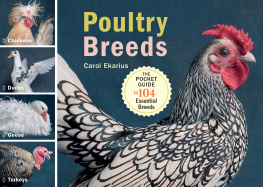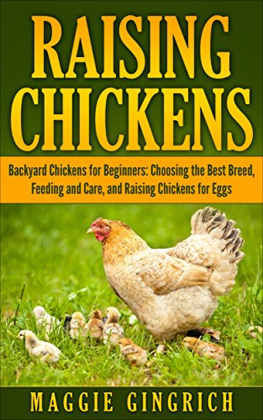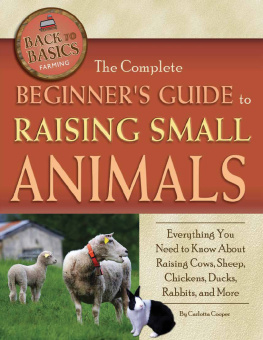THIRD EDITION
Storeys Guide to
RAISING
TURKEYS
Breeds Care Marketing

Don Schrider

The mission of Storey Publishing is to serve our customers by publishing practical information that encourages personal independence in harmony with the environment.
Edited by Deborah Burns
Art direction and book design by Cynthia N. McFarland
Cover design by Cynthia N. McFarland, based on a design by Kent Lew
Text production by Theresa Wiscovitch
Cover photograph of Royal Palm turkeys by Mark J. Barrett/Alamy
Don Schriders photograph courtesy of the author
Illustrations by Elayne Sears, except for chart, , by Ilona Sherratt
Indexed by Samantha Miller
2013 by Don T. Schrider
Ebook production by CodeMantra
Ebook version 1.0
December 3, 2013
All rights reserved. No part of this book may be reproduced without written permission from the publisher, except by a reviewer who may quote brief passages or reproduce illustrations in a review with appropriate credits; nor may any part of this book be reproduced, stored in a retrieval system, or transmitted in any form or by any means electronic, mechanical, photocopying, recording, or other without written permission from the publisher.
The information in this book is true and complete to the best of our knowledge. All recommendations are made without guarantee on the part of the author or Storey Publishing. The author and publisher disclaim any liability in connection with the use of this information.
Storey books are available for special premium and promotional uses and for customized editions. For further information, please call 1-800-793-9396.
Storey Publishing
210 MASS MoCA Way
North Adams, MA 01247
www.storey.com

Contents

Preface
There is really more hope in turkey production for the beginner who starts out by informing himself thoroughly and uses sound judgment in developing his turkey project than for the turkey raiser with years of experience and indifferent success.
From M ARSDEN AND M ARTINS T URKEY M ANAGEMENT , 1945
THESE WISE WORDS HAVE INSPIRED me throughout my time with poultry. It reminds me that there is advantage in having some flexibility in our thinking and keeping an open attitude to new information. You can say that much of our own success comes from the informed help of others.
My experiences in poultry surely validate this. Lessons from master breeders of poultry have been some of the greatest moments of my life. These men and woman have been generous in sharing ideas with a young upstart, often with nothing for them to gain. I believe it is for the love of the birds that we find commonality, and it is in the sharing that we fulfill a higher purpose.
Id like to thank some of my mentors, without whom I would have had very little to share: Richard Holmes, Frank Reese, Jr., James P. Rines Jr., Clint Grimes, Francis LeAnna, Al Watts, Wells LaFon, Donald Boger, Donald Grimes, and John Arbaugh. Additionally, others who may not realize their influence include: Craig Russell, Paul Gilroy, Mark Atwood, Ken Bowles, Danny Williamson, Marjie Bender, Paul Kroll, Miki Adams, Doug Empie, Steve Moise, Alex Hitt, William Yockey, Gay and Rudy Biordi, Tom Walker, Dave Olson, and John Hass.
A host of people made this book possible. Many thanks to my editor, Deb Burns; the gang at Storey Publishing; my editing team Harvey Ussery, Frank Reese, Paul Gilroy, Michael Focazio, Jim Adkins; my fellow Home Depot employees and managers (who provided me encouragement and time off when I badly needed it), including Bhalla Gaurav, Brandon Hardy, Sandy Rodas, and many others too numerous to list. Thank you to Howard Kogan for pointing me in very good directions. A special thanks to Brenda Powell for doing all those things I could not do while writing and being patient with me. And we cannot forget Jeannette Beranger, whose networking skills are the reason Storey asked me to write this book please blame Jeannette for any mistakes.
Become an informed beginner, as Marsden and Martin recommended, and you will surely be successful. I wish you great success with your turkeys.
Lastly, Id like to dedicate this book to my father, Philip Schrider, my grandmother, Flora Richard, and my poultry mentor, Richard Holmes. There is more of each of you in my writing than you know.
God bless.
Don Thomas Schrider
If you know turkeys, it will usually follow that you are a successful turkey grower.
Frank R. Reese, Jr., master turkey breeder,
Lindsborg, Kansas

Introduction
MY GRANDMOTHER KEPT A FEW TURKEYS while growing up during the 1930s. They provided a feast for Thanksgiving and Christmas each year, plus income when she sold any extras. Nanny Richard kept mostly Bronze turkeys, though she tried Bourbon Reds and Blacks as well. The turkeys ranged around the farm, and her family provided only a minimal amount of grain and dairy products to supplement their diet. One of her fond memories was that the profits from her turkeys earned her a very nice winter coat one year.
Small farms were once commonplace in America. Modern agricultural practices have changed much over the past 70 years now turkeys are produced by the millions on specialized farms.
A renaissance is underway, however a renewed interest in keeping poultry in backyards, homesteads, and small diversified farms. Fueling this movement are concerns about food safety and a craving for better flavor and nutrition. For the king of the poultry yard, the humble turkey, this surge of interest could not have come at a better time.
Turkeys are wonderful and useful creatures. They produce succulent meat, rich eggs for cooking and baking, and nutrient-dense manure. They also can do specialized labor around the farm such as reducing insect populations and fertilizing fields by distributing their manure as they range. Turkeys are curious and social by nature. Imagine a large bird that greets you as you approach and will answer you well, gobble at you when you talk. Their friendly attitude and social nature make turkeys very enjoyable pets.
As people seek appropriate knowledge to guide them in pasture-based production methods, an entire field of abandoned knowledge from the first half of the twentieth century is becoming useful again. This book hopes to marry current understandings with time-tested knowledge to give solid information that can benefit turkey keepers of any scale.

The proper way to hold a turkey is to wrap one arm around the bird so that its head faces forward and your hand is supporting the breast. With the other hand, you reach across and hold both of its shanks firmly but gently. In this way the turkey is under control, well supported, and unable to flap its wings, which could cause bruising.
Next page







